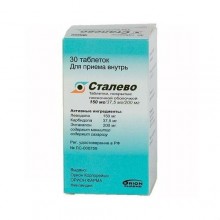



Stalevo - combined anti-parkinsonian drug, which is a combination of levodopa - metabolic precursor of dopamine, carbidopa - an aromatic amino acid decarboxylase inhibitor and entacapone - catechol-O-methyltransferase inhibitor (COMT). Levodopa increases the dopamine content in the brain. Dopamine is formed directly from levodopa with the participation of aromatic amino acid decarboxylase. The anti-parkinsonian effect of levodopa is due to its transformation into dopamine directly in the central nervous system. Levodopa is rapidly decarboxylated in peripheral tissues, turning into dopamine, which, however, does not penetrate through BBB. Carbidopa inhibits the process of decarboxylation of levodopa and the formation of dopamine in peripheral tissues, which indirectly leads to an increase in the amount of levodopa entering the central nervous system. As a result of inhibition of dopa-decarboxylase, levodopa biotransformed with the participation of catechol-O-methyltransferase (COMT) into the potentially dangerous metabolite 3-O-methyldopa (3-OMD). Entacapone is a reversible, specific inhibitor of COMT, mainly of peripheral action. Entacapone slows down the clearance of levodopa from the bloodstream, which leads to an increase in the bioavailability of levodopa, prolonging its therapeutic effect.
Parkinson's disease and parkinsonism (with the exception of drug) in cases where the use of a combination of levodopa + carbidopa is ineffective.
In 1 coated tablet contains: levodopa 150 mg, carbidopa in the form of monohydrate 35.5 mg, entacapone 200 mg.
Excipients: corn starch, mannitol, croscarmellose sodium, povidone, magnesium stearate.
Shell composition: hypromellose, sucrose, titanium dioxide, iron oxide yellow, iron oxide red, magnesium stearate, polysorbate 80, glycerin 85%.
No customer reviews for the moment.
The drug is taken orally, regardless of the meal, without dividing the tablet into pieces. The optimal daily dose is determined by careful individual selection. As a single dose, only 1 tablet of any dosage should be taken. The maximum daily dose is 1.5 g of levodopa, 2 g of entacapone, 375 mg of carbidopa (corresponds to 10 pills of Stalevo 150 / 37.5 / 200 mg).
If necessary, the introduction of more levodopa reduce the interval between doses of the drug and / or transfer the patient to treatment with Stalevo at a higher dosage (necessarily within the recommended dose). If a smaller amount of levodopa is required, then increase the intervals between taking the drug and / or transfer the patient to Stalevo treatment in a lower dosage. If other drugs containing levodopa are used simultaneously with Stalevo, then the recommendations for the total daily dose of the drug should be carefully followed.
- Severe abnormal liver function.
- angle-closure glaucoma.
- Pheochromocytoma.
- Combined use with non-selective MAO inhibitors of types A and B (for example, phenelzine, tranylcypromine).
- Combined use with selective MAO inhibitors of types A and B.
- Malignant neuroleptic syndrome and / or atraumatic acute rhabdomyolysis (including in history).
- Children's and teenage age up to 18 years.
- Pregnancy.
- Lactation period (breastfeeding).
- Hypersensitivity to the drug.
With caution should use the drug for:
- Severe cardiovascular and pulmonary insufficiency.
- Bronchial asthma.
- Liver disease.
- Kidney disease.
- Diabetes and other decompensated endocrine diseases.
- Erosive and ulcerative lesions of the digestive tract.
- Convulsions (in history).
- With a myocardial infarction in history (with persistent cardiac arrhythmias).
- Psychosis in history and / or during treatment.
- Depression with suicidal tendencies.
- Asocial behavior.
- Open-angle glaucoma.
Caution should be exercised while applying Stalevo with:
- Drugs that can cause orthostatic hypotension.
- With neuroleptics that block dopamine (especially dopamine D2 receptor antagonists).
- With tricyclic antidepressants, desipramine, maprolitine, venlafaxine.
- With warfarin and COMT metabolizable drugs (paroxetine).
The therapeutic effect of Stalevo is reduced, while taking it with dopamine receptor antagonists (some antipsychotics and antiemetic drugs), phenytoin, papaverine. When taken simultaneously with iron preparations, the effectiveness of Stalevo may decrease, since levodopa and entacapone form chelate complexes with iron ions in the gastrointestinal tract. It is necessary to observe the time interval of 2-3 hours between taking Stalevo and iron-containing preparations. The therapeutic effect of Stalevo may be reduced in patients receiving a high-protein diet, due to the competing action of levodopa and some amino acids. Steel is compatible with imizina and moclobemide, pyridoxine hydrochloride, diazepam, ibuprofen.
The drug is contraindicated for use in pregnancy (except in cases where the potential positive effect from taking the drug outweighs the possible risk to the development of the fetus) and during lactation.
It is not designed to eliminate extrapyramidal reactions caused by medication. Before planned general anesthesia, the drug can be taken as long as the patient is allowed oral administration. In the case of long-term therapy, Stalevo requires periodic monitoring of the functions of the liver, the system of hemopoiesis, kidneys, and the cardiovascular system. Monitoring the function of the cardiovascular system is required during the entire period of the initial dose adjustment of the drug.The use of the drug in open-angle glaucoma is possible only with careful control of intraocular pressure. When replacing Stalevo with levodopa + carbidopa therapy (without entacapone), an increase in the dose of levodopa will be required. Cancellation Stalevo spend slowly, if necessary, increasing the dose of levodopa. Therapy with Stalevo does not prevent the use of other anti-parkinsonian drugs. The daily dose of seleginin while taking with the drug Stalevo should not exceed 10 mg.
Influence on ability to drive motor transport and control mechanisms: entacapone in combination with levodopa causes drowsiness and episodic instant sleep. It is necessary to refuse to drive a car and work with machines and mechanisms during the period of taking the drug Stalevo.
Symptoms: increased severity of side effects, with the exception of allergic reactions that are dose-independent.
Treatment: hospitalization, gastric lavage, repeated administration of Activated charcoal. Control of the respiratory, cardiovascular and urinary systems; ECG monitoring, if necessary - antiarrhythmic therapy.
Pyridoxine is ineffective in Stalevo overdose.
Studies and clinical trials of Stalevo (Click to expand)